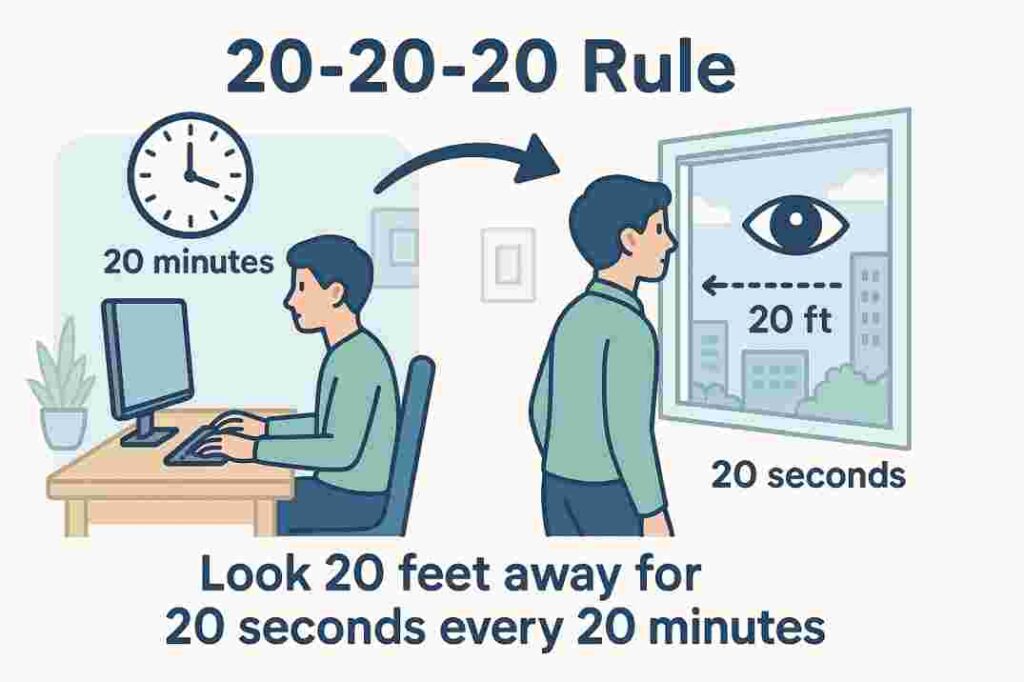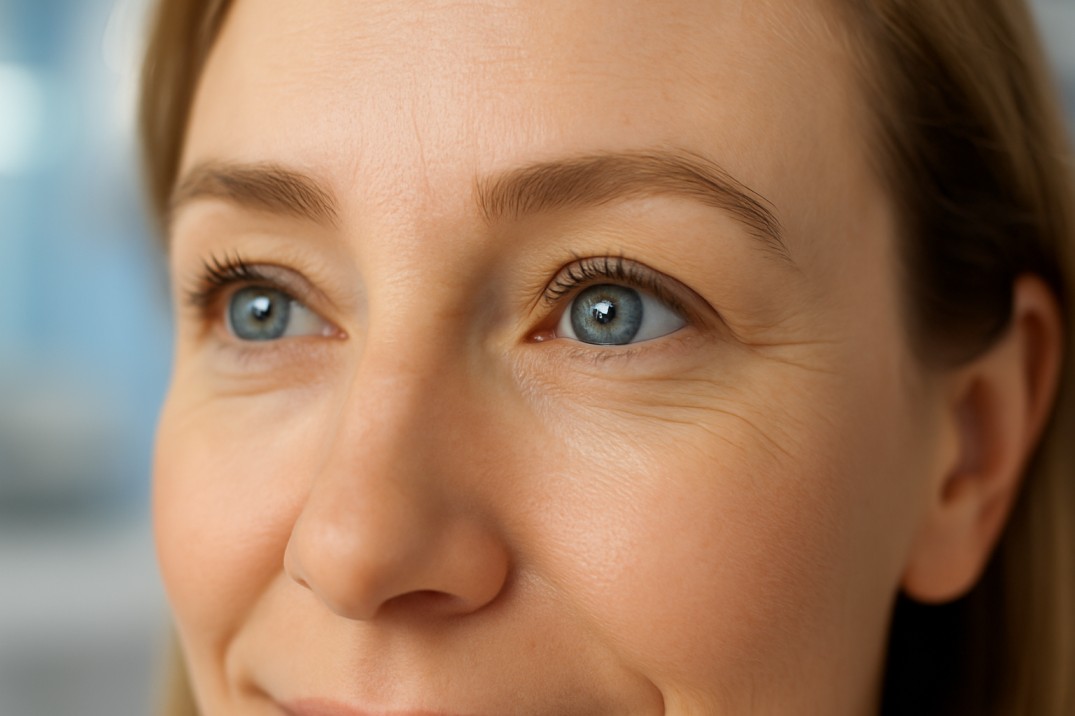Is Office Lighting Affecting Your Vision?
Executive Summary
If your eyes feel tired, dry, or irritated after a long workday, you’re experiencing a widespread occupational health issue. Recent 2024 studies reveal that 69-74% of people who routinely use computers and digital devices suffer from symptoms of digital eye strain, with office lighting serving as a primary contributing factor. As Seattle’s trusted eye care professionals at Cannon EyeCare, we’ve witnessed firsthand how poor workplace lighting impacts our patients’ daily comfort and long-term vision health.
Key Finding: Office lighting significantly affects vision health, causing everything from temporary eye strain to contributing to serious long-term eye health complications. The encouraging news? Most lighting-related vision problems are entirely preventable with proper knowledge and strategic adjustments.
How Office Lighting Affects Your Vision: The Science Explained
Clinical Overview: Office lighting fundamentally impacts vision health through multiple physiological mechanisms. Poor lighting conditions force the visual system beyond optimal operational parameters, resulting in measurable symptoms affecting 69-74% of office workers globally.
Your visual system represents one of the body’s most sophisticated sensory networks, designed to adapt across diverse lighting conditions. However, modern office environments frequently challenge these adaptive capabilities beyond their intended limits. Poor office lighting directly contributes to symptoms including eye strain, blurred vision, headaches, and concentration difficulties.
The Physiological Impact of Workplace Lighting
Contemporary research demonstrates that illuminance levels, color temperature, and natural light availability create measurable effects on visual comfort, alertness, and worker satisfaction. This constant visual adaptation can lead to ocular fatigue, particularly when lighting conditions fall outside optimal parameters.
Understanding Computer Vision Syndrome in Office Settings
Computer Vision Syndrome (CVS), also referred to as digital eye strain, encompasses a group of eye- and vision-related problems resulting from prolonged computer, tablet, e-reader, and cell phone use. Office lighting significantly compounds this condition when screens must compete with suboptimal surrounding light sources.
Types of Office Lighting That Cause Eye Strain
Fluorescent Lighting: The Leading Cause of Workplace Eye Problems
Fluorescent lighting systems remain prevalent in office environments due to their cost-effectiveness and energy efficiency. However, clinical evidence demonstrates significant health implications for sustained exposure to these lighting systems.
Research published in the American Journal of Public Health established that exposure to both traditional fluorescent lights and compact fluorescent lights (CFLs) can increase eye disease risk due to artificial ultraviolet (UV) light production.
Documented symptoms of fluorescent light exposure include:
- Ocular discomfort: Sore, burning, watery, or dry eyes
- Visual disturbances: Double vision and increased light sensitivity
- Neurological symptoms: Difficulty maintaining eye opening or work concentration
- Headache disorders: Particularly pronounced with flickering lights
- Migraine exacerbation: Increased frequency in susceptible individuals
Underlying mechanisms causing these symptoms:
- Invisible flickering: Imperceptible to conscious awareness yet processed by the nervous system
- Blue light emission: Elevated levels contributing to ocular strain
- UV radiation exposure: Potential contributor to long-term ocular damage
- Poor color rendering: Compromised visual task performance
LED Office Lighting: Best Solution for Eye Health
LED lighting technology has gained recognition in office settings due to superior performance characteristics and reduced health impacts compared to fluorescent systems.
Clinical advantages of LED office lighting:
- Stable illumination: Eliminates flicker-related symptoms
- Adjustable color temperature: Optimal range of 4000K-5000K for office environments
- Reduced blue light emission: Lower levels compared to fluorescent systems
- Enhanced energy efficiency: Superior performance with dimming capabilities
- Improved color rendering: Better visual task performance
Natural Light: The Clinical Gold Standard
Extensive research demonstrates that employees exhibit marked preferences for natural light, reporting enhanced satisfaction, improved health metrics, superior visual comfort, and increased productivity levels.
Benefits of natural light in office environments:
- Full-spectrum illumination: Supports healthy circadian rhythm regulation
- Reduced ocular strain: Compared to artificial lighting sources
- Enhanced color perception: Improved visual comfort and accuracy
- Mood enhancement: Documented improvements in alertness and well-being
Clinical Recognition: Identifying Vision Problems from Office Lighting
Immediate Symptom Assessment
Healthcare professionals should monitor for these primary indicators of lighting-related vision problems:
Primary Ocular Symptoms:
- Digital eye strain syndrome: Eyestrain, headaches, blurred vision, dry eyes, neck and shoulder pain
- Accommodation difficulties: Impaired ability to focus on close-up tasks
- Photosensitivity: Increased sensitivity to light sources
- Blepharospasm: Frequent blinking or involuntary squinting
- Asthenopia: Generalized eye fatigue and heaviness
Secondary Manifestations:
- Cognitive impact: Decreased concentration and work performance
- Productivity decline: Measurable reduction in task efficiency
- Mood alterations: Irritability and workplace stress
- Postural compensation: Neck and shoulder tension from adaptive positioning
Long-Term Vision Health Implications
A landmark 2011 study published in the American Journal of Public Health by researchers at The Australian National University established significant long-term health risks. The research demonstrated that fluorescent lighting may cause up to a 12% increase in UV-related eye diseases, with calculations suggesting approximately 3,000 additional cases of cataracts and 7,500 cases of pterygia annually in Australia alone.
The study specifically identified that working more than 45 hours weekly under fluorescent lighting systems can compromise long-term vision health, with excessive exposure potentially accelerating cataract development to as early as age 40.
Additional long-term complications may include:
- Age-related macular degeneration: Accelerated progression
- Pterygium development: Non-cancerous conjunctival growth
- Accelerated presbyopia: Earlier onset of near-vision difficulties
- Chronic dry eye syndrome: Persistent tear film dysfunction
Who’s Most at Risk? Understanding Your Vulnerability
People with Light-Colored Eyes
If you have blue or light-colored eyes, you may experience eyestrain and sensitivity problems more intensely than your friends with dark eyes. People who have darker eyes have more pigment in the layers of their eyes. Pigment helps protect the eyes from the effects of fluorescent light and UV light.
High-Risk Occupations and Work Patterns
- Knowledge workers spend 6+ hours daily on computers
- Employees in open office environments with overhead fluorescents
- Workers with existing vision problems or dry eye conditions
- Night shift workers are exposed to artificial lighting
- People over 40 experiencing age-related vision changes
Existing Health Conditions
Certain conditions increase your sensitivity to poor office lighting:
- Migraine disorders
- Dry eye syndrome
- Light sensitivity (photophobia)
- Autoimmune conditions affecting the eyes
- Previous eye surgery or injury
Scientific Evidence: Recent Studies on Office Lighting and Vision
Recent Research Findings
A 2024 comprehensive literature review found that Computer Vision Syndrome now affects approximately 69% of the general population, with reported prevalence ranging from 64% to 90% among computer users. The COVID-19 pandemic significantly amplified CVS, with studies reporting symptoms in up to 74% of individuals due to increased screen time for remote work, online learning, and social media use.
For office workers specifically, recent studies show:
- Nearly 68% of office workers experience digital eye strain symptoms
- Among university and office staff, prevalence ranges from 65-78%
- 60 million people globally suffer from CVS, with 1 million new cases occurring annually
Updated Screen Time and Work Statistics
Current work patterns (2024-2025 data):
- Average office workers spend 6-9 hours daily on computers and digital devices
- 44% of office workers spend 6-9 hours per day with computers at work
- Additional screen time at home for social media and entertainment compounds the problem
- Remote work trends have increased daily screen exposure by an average of 3.2 hours per week
2024-2025 Research Findings
A systematic review published in 2024 examining human-centric lighting in office settings analyzed 60 studies and found a complex interplay between visual comfort and non-visual effects. Key findings include:
- Daylight exposure significantly improves alertness and visual comfort
- Color temperature affects both physiological and psychological functions
- Shading systems and advanced glazing offer benefits but involve trade-offs
Recent 2024 meta-analysis findings:
- Overall CVS prevalence: 70% globally (95% CI: 64.0-77.8%)
- Asia and Africa show the highest rates: 71.2% prevalence
- Gender differences: Women show a higher prevalence than men
- Pandemic impact: CVS rates jumped from 50% pre-pandemic to 78% during COVID-19
Dynamic Lighting Research
A 2024 study on dynamic LED lighting found that varying illuminance and color temperature throughout the day can improve satisfaction, comfort, perceived naturalness of electric lighting, and mood compared to static lighting conditions.
Evidence-Based Solutions: Clinical Approaches to Office Lighting Optimization
Immediate Implementation Strategies
Workstation Ergonomic Adjustments:
- Monitor positioning: Position screens 15-20 degrees below eye level (4-5 inches from center), maintaining 20-28 inches viewing distance
- Glare reduction: Position screens perpendicular to windows to minimize reflective interference
- Task lighting integration: Implement adjustable LED desk lamps (4000K color temperature)
- Screen optimization: Ensure adequate ambient lighting maintains approximately half the brightness of screen displays
The 20-20-20 Protocol: To mitigate digital eyestrain effectively, implement the evidence-based 20-20-20 rule: every 20 minutes, direct visual focus to an object 20 feet distant for a minimum 20-second duration.
Environmental Controls:
- Natural light management: Utilize window treatments to regulate brightness and reduce glare
- Screen maintenance: Regular cleaning reduces glare-producing surface contamination
- Ambient lighting balance: Maintain consistent illumination, avoiding dramatic light-to-dark transitions
Advanced Lighting Solutions for Healthcare-Conscious Organizations
Professional Lighting System Upgrades:
- LED conversion: Install dimmable LED fixtures with tunable white technology
- Automated controls: Deploy daylight sensors for dynamic brightness adjustment
- Indirect illumination: Reduce harsh shadow formation through strategic light placement
- Individual controls: Provide workstation-specific lighting adjustment capabilities
Blue Light Management Protocols: Current research suggests that prolonged exposure to artificial blue light from digital devices may compromise long-term vision health. Mitigation strategies include:
- Specialized filtering eyewear: Blue light reduction glasses for high-exposure individuals
- Screen filtration systems: Physical filters with blue light attenuation properties
- Software applications: Programs enabling automatic color temperature adjustment
- LED specifications: Select lighting systems with reduced blue light emission profiles
Creating an Eye-Friendly Office Environment
Lighting Design Principles
Layer Your Lighting:
- Ambient lighting for general illumination
- Task lighting for specific work activities
- Accent lighting to reduce contrast and provide visual interest
Color Temperature Guidelines: A range of 4000K to 5000K provides a natural white light that feels both crisp and comfortable, neither too warm (yellowish) nor too cool (bluish).
Brightness Recommendations:
- General office work: 300-500 lux
- Computer work: 200-300 lux
- Detailed tasks: 500-1000 lux
- Paper-based reading: 500-750 lux
Workplace Advocacy
Working with Your Employer:
- Document lighting-related symptoms and productivity impacts
- Propose cost-effective solutions like desk lamps or screen filters
- Suggest a workplace lighting assessment
- Form a committee with colleagues experiencing similar issues
Clinical Guidelines: When to Seek Professional Eye Care
Professional Consultation Indicators
Healthcare providers should recommend comprehensive eye examinations when patients report:
- Persistent ocular symptoms: Eye strain continuing despite environmental modifications
- Progressive vision changes: Deteriorating visual acuity or frequent prescription adjustments
- Severe photophobia: Light sensitivity interfering with daily activities
- Chronic cephalgia: Severe headaches or migraines triggered by light exposure
- Dry eye syndrome: Symptoms unresponsive to over-the-counter tear replacement therapy
Comprehensive Eye Examination Protocol
Computer Vision Syndrome and digital eyestrain require a thorough diagnostic evaluation emphasizing visual requirements at computer and digital device working distances. Regular examinations enable:
- Early detection: Identification of lighting-related ocular damage in the initial stages
- Underlying condition assessment: Recognition of vision problems exacerbated by poor lighting
- Specialized prescriptions: Computer-specific vision correction recommendations
- Protective interventions: Therapeutic eyewear and treatment protocol development
Evidence-Based Prevention Strategies for Long-Term Vision Health
Daily Ocular Health Protocols
Workplace Ergonomic Practices:
- Postural maintenance: Proper positioning and screen distance optimization
- Comprehensive illumination: Adequate lighting for all visual tasks
- Systematic breaks: Regular interruption of sustained close-up work
- Hydration support: Adequate fluid intake supporting natural tear production
Comprehensive Eye Care Routine:
- Conscious blinking: Deliberate increase in blink frequency (people reduce blinking by 50% during computer use; target 10-15 blinks per minute)
- Tear supplementation: Preservative-free artificial tears as clinically indicated
- Hygiene protocols: Complete makeup removal, preventing ocular irritation
- UV protection: Broad-spectrum sunglasses for outdoor exposure
Technology Integration and Management Tools
Screen Optimization Systems:
- Display calibration: Optimal brightness and contrast adjustment for visual comfort
- Dark mode utilization: When available and appropriate for reduced eye strain
- Blue light software: Installation of filtering programs for extended computer use
- Break reminder systems: Automated prompts for systematic eye rest periods
Environmental Monitoring Applications:
- Ambient light measurement: Smartphone applications for illumination assessment
- Color temperature programs: Automatic adjustment of screen characteristics
- Smart lighting integration: Automated adjustment throughout daily cycles
Future of Office Lighting and Vision Health
Emerging Technologies
Circadian Lighting Systems: Dynamic lighting with daily variation in illuminance and color temperature levels shows promise for improving health, well-being, and experience of office occupants.
Smart Office Integration:
- Sensors that automatically adjust lighting based on occupancy and tasks
- Personalized lighting profiles for individual workers
- Integration with wearable devices to monitor eye strain
Workplace Design Trends
Modern office design increasingly emphasizes:
- Biophilic design incorporating natural light
- Flexible lighting zones for different activities
- Employee control over their lighting environment
- Wellness-focused workplace standards
Resources and Citations
Key Scientific Studies Referenced
1. Computer Vision Syndrome Prevalence Research (2024) “Computer vision syndrome: a comprehensive literature review” Published in PMC (PubMed Central). This comprehensive 2024 literature review analyzed studies from 2014-2024, finding that Computer Vision Syndrome now affects 69-74% of digital device users globally. The study highlighted the significant impact of the COVID-19 pandemic, which increased CVS prevalence from 50% pre-pandemic to 78% during lockdown periods. Access Study: https://pmc.ncbi.nlm.nih.gov/articles/PMC11901492/
2. Fluorescent Lighting and Eye Disease Risk (2011) “Eye Disease Resulting From Increased Use of Fluorescent Lighting as a Climate Change Mitigation Strategy” Published in American Journal of Public Health by Australian National University researchers This landmark study found that fluorescent lighting may cause up to a 12% increase in UV-related eye diseases, potentially resulting in 3,000 additional cataract cases and 7,500 cases of pterygia annually in Australia alone. The research provides crucial evidence linking workplace fluorescent lighting to long-term eye health risks. Access Study: https://pmc.ncbi.nlm.nih.gov/articles/PMC3222423/
3. Office Lighting Effects on Worker Health and Performance (2024) “Subjective and objective survey of office lighting: effects on alertness, comfort, satisfaction, and safety” Published in PMC (PubMed Central). This 2024 study of 85 office employees examined how lighting quality affects worker alertness, visual comfort, and job satisfaction. The research demonstrated that natural light significantly improves workplace comfort and performance, while poor lighting increases discomfort and stress among office workers. Access Study: https://pmc.ncbi.nlm.nih.gov/articles/PMC9437655/
Clinical Conclusion: Evidence-Based Recommendations for Vision Health
Office lighting represents a significant determinant of occupational vision health, affecting 69-74% of computer users with symptoms ranging from acute eye strain to serious long-term vision complications. However, individuals and organizations are not defenseless against these effects. Through an in-depth understanding of lighting-vision relationships, recognition of early warning indicators, and implementation of evidence-based solutions, most lighting-related vision problems are entirely preventable.
Key Clinical Findings:
- Prevalence: Poor office lighting affects nearly three-quarters of computer users globally
- Primary causes: Fluorescent lighting poses particular risks due to flickering, UV emission, and inadequate color rendering
- Immediate interventions: Simple adjustments, including proper screen positioning, 20-20-20 protocol implementation, and task lighting, can provide rapid symptomatic relief
- Professional care threshold: When symptoms persist despite environmental modifications, a comprehensive eye examination becomes essential
Professional Recommendations:
Your vision represents an irreplaceable asset requiring proactive protection. If you’re experiencing persistent eye strain or vision problems related to office lighting exposure, prompt professional evaluation is strongly recommended rather than waiting for symptom progression.
At Cannon EyeCare, our clinical team specializes in addressing work-related vision problems and developing personalized treatment protocols for individual patient needs. Our comprehensive approach integrates advanced diagnostic technology with evidence-based care focused on long-term eye health optimization.
Ready to protect your vision? Schedule your professional consultation today at our convenient Seattle locations in University Village or Pike Place Market. We proudly serve patients throughout the Seattle metro area, including Capitol Hill, Ballard, Fremont, and surrounding communities with specialized workplace vision care.
FAQs
-
Common signs include headaches, blurred vision, dry eyes, and eye fatigue after work. Harsh fluorescent lights or dim lighting typically cause these symptoms.




